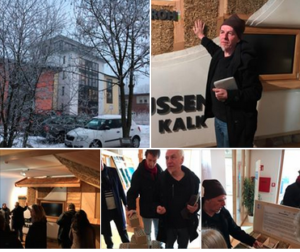The TACCLE4-CPD project takes further steps in its work – Part One: Reflections on our project meeting
As I had told in my earlier blog of December 2017, our institute ITB is involved in a new European project TACCLE4-CPD. This project is the fourth one in the TACCLE project family that supports teachers and trainers in integrating the use of digital tools and web resources into teaching and learning processes. Our project is developing tools and concepts for continuing professional development of teachers and trainers in different educational sectors. (For further information on the background and on the earlier TACCLE project see my blog of the 9th of December 2017.)
Now we had our second project meeting and we were able to see, how we can bring our activities with different educational sectors and with different “Intellectual Outputs” together. As I had mentioned in my previous blog, the earlier TACCLE projects had been working with general education – with primary and (lower) secondary schools. In our project some partners continue the work with focus on these educational sectors whilst others bring into project insights from adult education (AE) and vocational education and training (VET). In our kick-off meeting we had a first look at the work program and on the starting points of different partners. Now we were having reports on activities of different partners – both concerning the fieldwork and the conceptual work. In this way we were able to take further steps in adjusting our activities to each other and in including different contributions to the Intellectual Outputs. Below I will firstly discuss the progress with our work program and then some specific issues from perspective of the German team and of the VET sector.
Progress with ‘streamlining’ the work program and the partners’ activitities
In our meeting the dynamics was as follows: We had firstly activity reports of one or two partners, then we noticed that they served as a lead-in to some of the Intellectual Outputs. We had a brief debate with some challenging issues – and then ended up with a common conclusion that ‘streamlined’ the work for all of us. Below I will take up some topics that illustrate this:
- Analyses of current policies to promote digitisation and digital competences: With the activity reports we were caught with the contrast between countries that have centralised educational policies (driven by the National Curriculum) and others with more fragmented power structures and policy processes. This led us to a brief debate on what is merely ‘local/regional’ and what counts as ‘policies’. With a little help of mindmaps and diagrams from other project we found a good formulation for streamlining our mapping and analyses: “Policies looking for appropriate practices – innovative practices and R&D initiatives looking for policy support”. In this way we could provide a European group picture without giving too much emphasis on explaining different policy contexts and instead draw attention to the ‘implementation realities’.
- Developing a tool for quality assurance: In this context the responsible partner informed of their ongoing qualitative study with schools participating in the eTwinning programme. This triggered a discussion, whether other partners should replicate a similar study or not. However, in the course of discussion we noted that the study is shaping a matrix for analysing quality issues and in this way contributing to the project.
- Developing a Route Map for promoting digital competences and Planning tools for institutional managers: In this context the responsible partner presented earlier versions of such Route Maps. They had been successfully implemented in earlier TACCLE projects and in national follow-up activities. Another partner presented a somewhat simplified and more condensed version (developed in another predecessor project) that could be taken as a basis of the planning tool. We agreed to merge the tasks and work with both variants of the tools.
—
I guess this is enough as reporting on our meeting. We had several other points to discuss in the meeting. I will get back to them in due time. In my next post I will discuss the mapping and analysing of policies from the German perspective and with emphasis on the VET sector.
More blogs to come …
 A European Framework for Quality and Effective Apprenticeships (2018/C 153/01)
A European Framework for Quality and Effective Apprenticeships (2018/C 153/01) 
